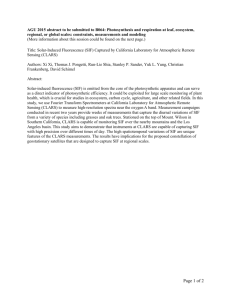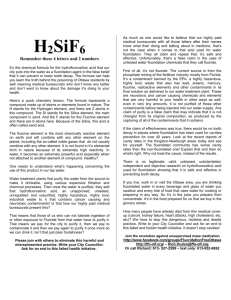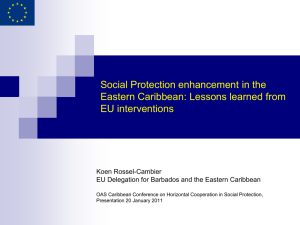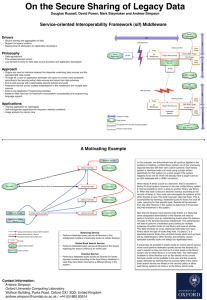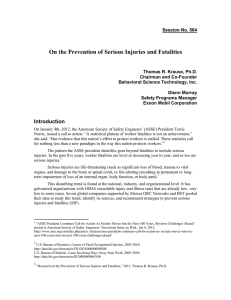NeuroToxicology® 21(6): 1091‑1100, 2000 Copyright © 2000 by
advertisement
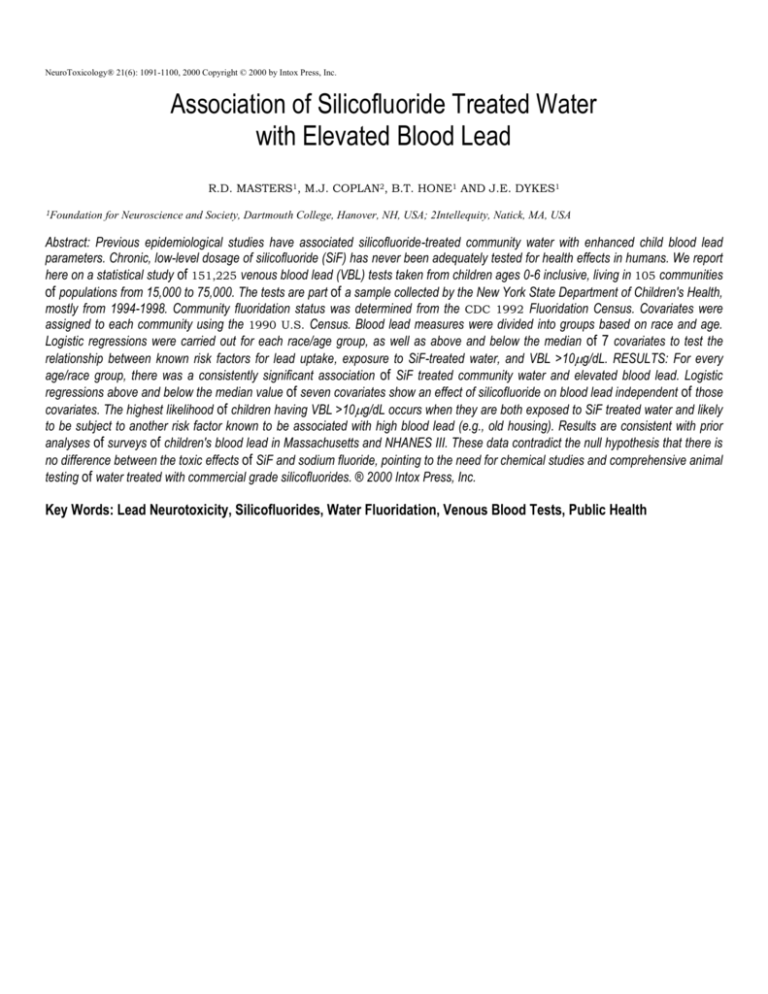
NeuroToxicology® 21(6): 1091-1100, 2000 Copyright © 2000 by Intox Press, Inc. Association of Silicofluoride Treated Water with Elevated Blood Lead R.D. MASTERS1, M.J. COPLAN2, B.T. HONE1 AND J.E. DYKES1 1Foundation for Neuroscience and Society, Dartmouth College, Hanover, NH, USA; 2Intellequity, Natick, MA, USA Abstract: Previous epidemiological studies have associated silicofluoride-treated community water with enhanced child blood lead parameters. Chronic, low-level dosage of silicofluoride (SiF) has never been adequately tested for health effects in humans. We report here on a statistical study of 151,225 venous blood lead (VBL) tests taken from children ages 0-6 inclusive, living in 105 communities of populations from 15,000 to 75,000. The tests are part of a sample collected by the New York State Department of Children's Health, mostly from 1994-1998. Community fluoridation status was determined from the CDC 1992 Fluoridation Census. Covariates were assigned to each community using the 1990 U.S. Census. Blood lead measures were divided into groups based on race and age. Logistic regressions were carried out for each race/age group, as well as above and below the median of 7 covariates to test the relationship between known risk factors for lead uptake, exposure to SiF-treated water, and VBL >10g/dL. RESULTS: For every age/race group, there was a consistently significant association of SiF treated community water and elevated blood lead. Logistic regressions above and below the median value of seven covariates show an effect of silicofluoride on blood lead independent of those covariates. The highest likelihood of children having VBL >10g/dL occurs when they are both exposed to SiF treated water and likely to be subject to another risk factor known to be associated with high blood lead (e.g., old housing). Results are consistent with prior analyses of surveys of children's blood lead in Massachusetts and NHANES III. These data contradict the null hypothesis that there is no difference between the toxic effects of SiF and sodium fluoride, pointing to the need for chemical studies and comprehensive animal testing of water treated with commercial grade silicofluorides. ® 2000 Intox Press, Inc. Key Words: Lead Neurotoxicity, Silicofluorides, Water Fluoridation, Venous Blood Tests, Public Health INTRODUCTION Over 91% of US fluoridated water is treated with either sodium silicofluoride (Na2SiF6) or fluosilicic acid (H2SiF6) - henceforth, the silicofluorides or SiFs. Less than 10% is treated with simple sodium fluoride (NaF). Whereas NaF was the model compound used in the 1940s for demonstrating safety and efficacy, and has been submitted to exhaustive animal testing for decades (e.g., McClure, 1962; Largent, 1961; Dunipace et al., 1995, 1996, 1998a, 1998b; Jackson et al., 1997), the same cannot be said of the SiFs. The Assistant Administrator of the EPA recently acknowledged (Fox, 1999) that his agency knew of no study of human health effects of chronic low-level exposure to either of the SiFs. Here we report data suggesting that SiF may enhance the uptake of lead from other environmental sources. As is well known, many environmental and behavioral risk factors have previously been associated with increased lead levels among children. Among these are age, race, sex, income (or poverty), size of community (esp. between urban areas of greater and less than 1 million as well as between urban, suburban, and rural communities), location of community (including presence of soils with high lead levels), age of housing (presence of lead paint), lead in excess of 15 ppb in public water supplies, individual calcium or iron deficiency, maternal smoking, parental education and alcohol consumption (e.g., Needleman, 1992; Hense et al., 1992; Cezard et al., 1992; Weitzman et al., 1993). Using community rates, a study of over 238,000 Massachusetts children found independent relationships for blood lead levels and "median per capita income, percentage of housing built before 1950, percentage of the population who were Black, percentage of children screened, and a 'poverty index'." (Sargent et al., 1995). Although not found in that study, other researchers have also found higher blood lead levels among Hispanics (Snyder et al., 1995). Recently, we carried out a further analysis of the Massachusetts blood lead data used by Sargent et al. (op cit) We found that there was a statistically significant (p = 0.001 of better) correlation between community use of SiFs as reported by the CDC's fluoridation census (CDC, 1992) and a higher level of children's blood lead parameters, controlling for community factors commonly associated with blood lead, such as rates of housing built before 1950 and exposure to water containing over 15 ppb first draw lead (Masters and Coplan,1999a) Moreover, as predicted by our model (Masters and Coplan, 1999b), there were statistically significant interactions between these risk-factors and SiF usage as predictors of higher blood lead. A second study has recently been completed, based on the Third National Health and Nutrition Evaluation Survey (NHANES III). Blood lead data for over 4,000 children living in 35 counties with a population over 500,000 was compared with county fluoridation status using the CDC's 1992 Fluoridation Census. The percent of each county population receiving silicofluoride treated water was calculated and each county was assigned to one of three groups. The "high" group comprised counties in which a total of 92%a of the population received SiF-treated water. The "low" group comprised a population only 6% of which received SiF-treated water. A relatively small group of counties with "intermediate" exposure comprised a population with about a 50% chance of receiving SiF-treated water. Controlling at the individual level for covariates usually associated with lead uptake, elevated blood lead was statistically significant, again with p = 0.001 or better, with High/ Low risk ratios in the range of 1.5 to 2.0 depending on age and race (Masters, Coplan and Hone, 1999 and in preparation). The new analysis reported here is completely consistent with these earlier analyses of data from Massachusetts and NHANES Ill. Using New York State Health Department individual blood lead data for children 0-6, collected mostly between 1994 and 1998 by the Bureau of Children's Health, a multivariate study was done on data for over 151,225 children living in New York communities between 15,000 and 75,000 in population, of which 28 use SiF and 77 do not (one community using mixed chemicals had to be dropped from the analysis). We find that SiF is consistently associated with increased risk of having VBL>l0mg/dL for virtually any race /age group, controlling for most factors commonly associated with increased blood lead. Please send requests for reprints to Dr. Roger D. Masters, Department of Government, Dartmouth College, 6108 Silsby Hall, Hinman Box 6108, Henover, NH 03755-3547, USA, Phone: (603) 646-2153, Fax: (603) 646-0508, E-mail: roger.d.masters@dartmouth.edu Submitted: December 15, 1999 Accepted: July 14, 2000


